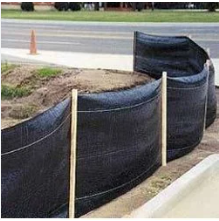How Long Does a Silt Fence Last? Maintenance and Durability Tips
A silt fence is an essential tool for erosion control and sediment management in construction, landscaping, and agricultural projects. Designed to filter runoff water and prevent soil displacement, silt fences help maintain environmental compliance and protect nearby waterways from sediment pollution.
But how long does a silt fence last? What factors affect its durability and effectiveness? Proper installation, routine maintenance, and timely replacement play crucial roles in ensuring that your silt fence functions optimally.
This guide will explore the lifespan of a silt fence, factors that influence its durability, and best practices for maintenance and replacement.
1. How Long Does a Silt Fence Last?
What is a silt fence? depends on multiple factors, including material quality, environmental conditions, and maintenance frequency. In general:
✔ Temporary silt fences last 6 months to 1 year in standard conditions.
✔ Heavy-duty silt fences with reinforced materials can last 1–2 years or longer.
✔ Poorly maintained silt fences can fail in weeks or months due to neglect or severe weather.
Since silt fences are designed as temporary erosion control measures, they require regular inspections and eventual replacement to remain effective.
2. Factors That Affect Silt Fence Durability
Several factors influence the longevity of a silt fence. Understanding these factors helps in choosing the right fence, maintaining it properly, and extending its lifespan.
1. Quality of Material
✔ Geotextile Fabric Type – High-quality woven or non-woven geotextile fabric provides better durability than low-grade materials.
✔ UV Resistance – Some fabrics degrade quickly under sunlight, while UV-resistant fabrics last longer.
✔ Post Strength – Wooden stakes may deteriorate faster than metal or reinforced plastic posts.
Tip: Choose a heavy-duty silt fence for long-term projects or areas with high water flow and sediment loads.
2. Environmental Conditions
✔ Rainfall and Storms – Frequent heavy rain can saturate and weaken the fabric.
✔ Wind Exposure – High winds can pull stakes loose and cause fabric tears.
✔ Soil Type – Sandy or unstable soils can cause the fence to sink or collapse faster.
✔ Vegetation Growth – Overgrown plants can put pressure on the fence, reducing its effectiveness.
Tip: Installing a reinforced silt fence in harsh weather conditions can extend its lifespan.
3. Installation Quality
✔ Trench Depth – The bottom of the silt fence should be buried at least 6 inches to prevent undercutting.
✔ Proper Post Spacing – Posts should be placed no more than 6 feet apart for stability.
✔ Secure Fastening – Fabric should be tightly secured to posts to prevent sagging.
✔ Slope Placement – Installing the fence along contours rather than directly downslope increases effectiveness.
Tip: Poor installation leads to early failure. Ensure correct trenching, staking, and anchoring for maximum durability.
4. Maintenance and Inspections
✔ Regular Inspections – Silt fences should be checked after heavy rain and at least every two weeks.
✔ Repairs – Fix tears, sagging, or loose posts immediately to prevent failures.
✔ Sediment Removal – Accumulated sediment should be removed when it reaches half the fence height.
Tip: A well-maintained silt fence lasts significantly longer than one left unattended.
3. How to Properly Maintain a Silt Fence
Routine maintenance is essential for extending the life of a silt fence and ensuring it functions effectively. Here are key maintenance practices:
1. Inspect the Silt Fence Regularly
✔ Check the fence every 1–2 weeks and after storms.
✔ Look for tears, fallen stakes, or sediment buildup.
✔ Ensure the fabric remains securely attached to the stakes.
2. Remove Excess Sediment
✔ Once sediment buildup reaches half the height of the fence, remove it to maintain efficiency.
✔ Use shovels or equipment to carefully remove sediment without damaging the fence.
✔ Dispose of sediment properly to prevent further erosion.
3. Repair Any Damage Immediately
✔ Replace torn fabric with new geotextile material.
✔ Reinforce or replace weak stakes that have shifted or broken.
✔ Use zip ties, nails, or staples to reattach loose fabric.
4. Reinforce Weak Areas
✔ Add extra stakes or support posts if sections of the fence appear weak.
✔ For fences under heavy water flow, install double-layered geotextile fabric.
✔ Apply extra anchoring in areas prone to high winds.
5. Control Vegetation Growth
✔ Keep surrounding vegetation trimmed to prevent excess weight on the fence.
✔ Avoid planting large shrubs or trees near the fence line.
6. Monitor Drainage Patterns
✔ Ensure that water is flowing through the fence as intended, not eroding around or under it.
✔ If undercutting occurs, add more soil and compact it around the base.
4. When to Replace a Silt Fence
Even with proper maintenance, silt fences have a limited lifespan. Signs that indicate it’s time for a replacement include:
✔ Significant fabric wear and tear – Large rips or holes that can’t be repaired.
✔ Multiple post failures – Stakes are continuously breaking or shifting.
✔ Persistent undercutting or washouts – Water is consistently flowing under the fence.
✔ Severe sagging or collapse – The fence no longer holds sediment effectively.
If a silt fence loses its integrity, replacing it promptly prevents environmental damage, fines, and compliance issues.
5. Best Practices for Extending Silt Fence Lifespan
✔ Use high-quality geotextile fabric with UV resistance for longer durability.
✔ Install posts deeper (at least 12–18 inches) for better anchoring.
✔ Add reinforcement such as additional support posts in high-impact areas.
✔ Combine silt fences with other erosion control methods, like straw wattles or sediment basins, for added protection.
✔ Monitor and adapt – Adjust maintenance and installation based on weather conditions.
By following these best practices, silt fences can last longer and remain effective in erosion control efforts.
6. Alternatives to Silt Fences for Long-Term Erosion Control
If you need longer-lasting sediment control solutions, consider these alternatives:
1. Wattle Barriers
✔ Made from straw or coir logs, they filter sediment while allowing water flow.
2. Geotextile Erosion Control Mats
✔ Provide permanent soil stabilization on slopes and embankments.
3. Sediment Basins or Rock Check Dams
✔ Capture large amounts of runoff sediment in areas with high erosion potential.
4. Vegetative Buffer Strips
✔ Use grasses and plants to absorb and filter runoff naturally.
These alternatives can be combined with silt fences to create a comprehensive erosion control system.
Conclusion
A silt fence typically lasts between 6 months to 2 years, depending on material quality, installation, maintenance, and environmental conditions. Proper upkeep, including regular inspections, sediment removal, and timely repairs, can extend its effectiveness and durability.
When a silt fence reaches the end of its lifespan, replacing it promptly ensures continued erosion control and environmental compliance.
By following best practices for maintenance and installation, you can maximize the lifespan of your silt fence, protecting both your project and the surrounding environment.




